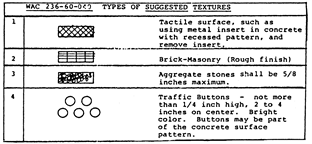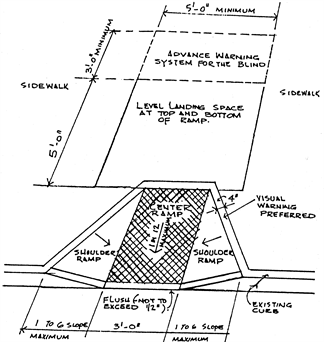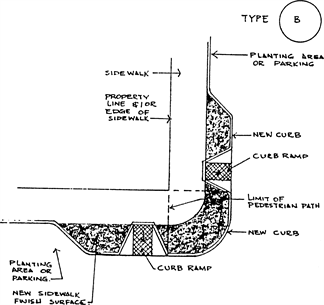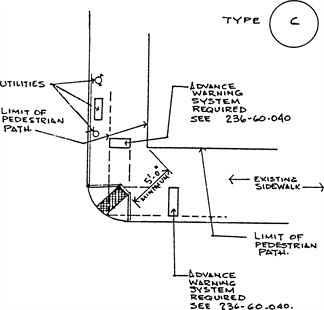Chapter 200-340 WAC
Last Update: 11/17/11SUGGESTED DESIGN AND CONSTRUCTION STANDARDS OF SIDEWALK AND CURB RAMPS FOR THE PHYSICALLY HANDICAPPED PERSON WITHOUT UNIQUELY ENDANGERING THE BLIND
WAC Sections
| HTMLPDF | 200-340-001 | Purpose. |
| HTMLPDF | 200-340-005 | Scope. |
| HTMLPDF | 200-340-010 | Definition. |
| HTMLPDF | 200-340-020 | Design standards. |
| HTMLPDF | 200-340-030 | Advance warning system for the blind. |
| HTMLPDF | 200-340-040 | Types of suggested textures. |
| HTMLPDF | 200-340-050 | Curb ramp types. |
| HTMLPDF | 200-340-060 | Curb ramp typical. |
| HTMLPDF | 200-340-070 | Curb ramp—Type "A." |
| HTMLPDF | 200-340-080 | Curb ramp—Type "B." |
| HTMLPDF | 200-340-090 | Curb ramp—Type "C." |
| HTMLPDF | 200-340-100 | Factors to be considered. |
PDF200-340-001
Purpose.
The purpose of this chapter is to provide several suggested model design, construction, and location standards to aid counties, cities, and towns in constructing curb ramps to allow reasonable access to the crosswalk for physically handicapped persons without uniquely endangering blind persons in accordance with chapter 137, Laws of 1977 ex. sess. (chapter 35.68 RCW).
[Statutory Authority: 2011 c 43. WSR 11-23-093, recodified as § 200-340-001, filed 11/17/11, effective 11/17/11. Statutory Authority: RCW 35.68.076. WSR 78-02-066 (Order 77-5), § 236-60-001, filed 1/24/78.]
PDF200-340-005
Scope.
The design construction and location standards set forth in chapter 236-60 WAC are suggestions only, and must be read in conjunction with the requirements of RCW 35.68.075 and any applicable code.
If these suggested standards are followed they should be used as a guide and not as a substitute for engineering judgment based on the conditions existing at any particular location.
[Statutory Authority: 2011 c 43. WSR 11-23-093, recodified as § 200-340-005, filed 11/17/11, effective 11/17/11. Statutory Authority: RCW 35.68.076. WSR 78-02-066 (Order 77-5), § 236-60-005, filed 1/24/78.]
PDF200-340-010
Definition.
As used in this chapter, the following words shall have the following meanings:
(1) Handicapped pedestrian - A pedestrian, or person in a wheelchair, who has limited mobility, stamina, agility, reaction time, impaired vision or hearing, or who may have difficulty walking, with or without assistive devices.
(2) Curb ramp - An interruption in a curb with a ramp from roadway to walk which forms a part of the accessible route of travel, no part of which projects into the roadway. It includes a center ramp and two shoulder slopes.
(3) Center ramp - The sloped surface providing pedestrian access to the roadway.
(4) Shoulder slope - The sloped flared sides on each side of the center ramp, providing a gradual incline from the edge of the center ramp to the sidewalk.
(5) Landing - A level area at least as wide as and, as long as, the width (except as otherwise provided), and within or at a terminus of, a stair or ramp, but not less than 5"['] 0" in width.
(6) Main pedestrian path - The walkway used by the pedestrian traffic clear of utility poles, signs, and parking meters.
[Statutory Authority: 2011 c 43. WSR 11-23-093, recodified as § 200-340-010, filed 11/17/11, effective 11/17/11. Statutory Authority: RCW 35.68.076. WSR 78-02-066 (Order 77-5), § 236-60-010, filed 1/24/78.]
PDF200-340-020
Design standards.
The following construction standards are applicable to all curb-ramps set forth in this chapter.
(1) The width of the center ramps shall be at least thirty-six inches.
(2) Shoulder slopes shall not exceed one inch in 6.
(3) The center ramp slope shall not exceed 1 in 12 and the cross slope shall not exceed 1 in 50.
(4) Curb ramps should contain a slip-resistant surface.
(5) The site of the curb ramp should be graded and drained to eliminate pooling of water or the accumulation of ice or water on the ramp, the ramp landing, or at the toe of the ramp.
(6) Handrails shall not be used at any point of access along the curb ramp.
(7) Curb ramps should be outside of the main pedestrian path.
(8) Whenever curb ramps are placed in the main flow of pedestrian traffic, the following standards prevail:
(a) Align with the direction of pedestrian traffic.
(b) Advance warning system.
(9) The curb ramp should be distinguished from surrounding surfaces either by color or texture.
(10) There should be no abrupt change in elevation to exceed 1/2 inch.
(11) A landing 5 feet x 5 feet should be located at top and bottom of every curb ramp.
[Statutory Authority: 2011 c 43. WSR 11-23-093, recodified as § 200-340-020, filed 11/17/11, effective 11/17/11. Statutory Authority: RCW 35.68.076. WSR 78-02-066 (Order 77-5), § 236-60-020, filed 1/24/78.]
PDF200-340-030
Advance warning system for the blind.
Whenever curb ramps are placed in the main flow of pedestrian traffic, an advance warning system is necessary in order to aid the blind. Warning materials should be adapted to local conditions. This texture should be in advance of a ramp curb. (See WAC 236-60-060.)
[Statutory Authority: 2011 c 43. WSR 11-23-093, recodified as § 200-340-030, filed 11/17/11, effective 11/17/11. Statutory Authority: RCW 35.68.076. WSR 78-02-066 (Order 77-5), § 236-60-030, filed 1/24/78.]
PDF200-340-040
Types of suggested textures.

Notes: | (a) | Type No. 1 is recommended for the center ramp surface. |
(b) | These standards are not a substitute for engineering judgment. They provide design guidance. |
[Statutory Authority: 2011 c 43. WSR 11-23-093, recodified as § 200-340-040, filed 11/17/11, effective 11/17/11. Statutory Authority: RCW 35.68.076. WSR 78-02-066 (Order 77-5), § 236-60-040, filed 1/24/78.]
PDF200-340-050
Curb ramp types.
The curb ramp depicted in WAC 236-60-060 is the suggested design for a typical curb ramp including warning system. The drawings contained in WAC 236-60-070, 236-60-080, and 236-60-090 show the suggested location for curb ramps in three different but typical curb situations. All of these drawings are guidelines and are intended to show design concept.
[Statutory Authority: 2011 c 43. WSR 11-23-093, recodified as § 200-340-050, filed 11/17/11, effective 11/17/11. Statutory Authority: RCW 35.68.076. WSR 78-02-066 (Order 77-5), § 236-60-050, filed 1/24/78.]
PDF200-340-060
Curb ramp typical.
The following is a design for a typical curb ramp:
 |
(1) | Texturing of center ramp recommended, with metal grid placed in wet concrete and then removed to leave ridged surface pattern. Pattern not to exceed 1/2" width. |
(2) | Advance warning strip (shown dotted), necessary when ramp is in direct line of main pedestrian path. |
[Statutory Authority: 2011 c 43. WSR 11-23-093, recodified as § 200-340-060, filed 11/17/11, effective 11/17/11. Statutory Authority: RCW 35.68.076. WSR 78-02-066 (Order 77-5), § 236-60-060, filed 1/24/78.]
PDF200-340-070
Curb ramp—Type "A."
 |
[Statutory Authority: 2011 c 43. WSR 11-23-093, recodified as § 200-340-070, filed 11/17/11, effective 11/17/11. Statutory Authority: RCW 35.68.076. WSR 78-02-066 (Order 77-5), § 236-60-070, filed 1/24/78.]
PDF200-340-080
Curb ramp—Type "B."
 |
(1) | This curb ramp type can be used with the existing planting area or with the sidewalk extension into the parking area. |
[Statutory Authority: 2011 c 43. WSR 11-23-093, recodified as § 200-340-080, filed 11/17/11, effective 11/17/11. Statutory Authority: RCW 35.68.076. WSR 78-02-066 (Order 77-5), § 236-60-080, filed 1/24/78.]
PDF200-340-090
Curb ramp—Type "C."
 |
This curb ramp type is acceptable when utilities are a conflict and/or the street grade exceeds twenty-five to one (4%). |
[Statutory Authority: 2011 c 43. WSR 11-23-093, recodified as § 200-340-090, filed 11/17/11, effective 11/17/11. Statutory Authority: RCW 35.68.076. WSR 78-02-066 (Order 77-5), § 236-60-090, filed 1/24/78.]
PDF200-340-100
Factors to be considered.
Factors which should be considered by a city, town or county when deciding whether to follow or deviate from the design, surface textures and/or location standards set forth in this chapter include, but are not limited to, the following:
(1) Street alignments and curb configurations that are substantially different from the curb situations shown.
(2) An adjacent driveway or loading ramp.
(3) Unusual sidewalk textures in the vicinity.
(4) Steeper street grades.
(5) Utility vaults.
(6) Whether a different design or location would assist the handicapped pedestrian without uniquely endangering the blind.
[Statutory Authority: 2011 c 43. WSR 11-23-093, recodified as § 200-340-100, filed 11/17/11, effective 11/17/11. Statutory Authority: RCW 35.68.076. WSR 78-02-066 (Order 77-5), § 236-60-100, filed 1/24/78.]